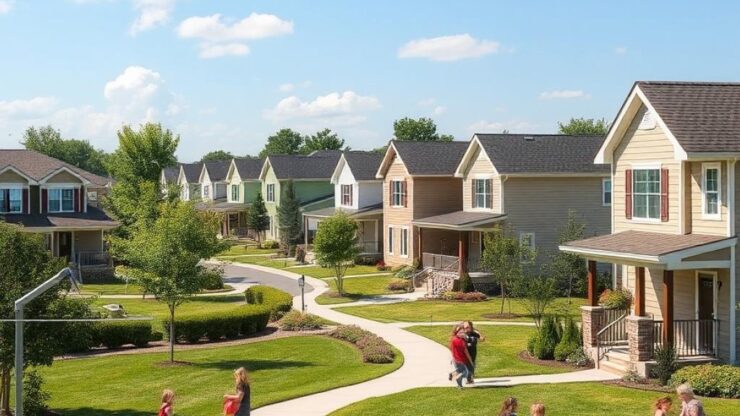Evaluating Affordability: Key Metrics for Family Housing
When assessing the affordability of housing markets, it’s crucial to look beyond mere home prices. The cost of living encompasses various factors that can significantly influence a family’s financial well-being. These elements include housing costs, utilities, transportation, and local taxes. Understanding how these components interact will help families make informed decisions about where to settle down.
To evaluate the affordability of potential housing markets, families should consider several key metrics. Each of these metrics offers insight into not only the price of homes but also the overall economic landscape of a given area. Below is a list of the most critical metrics to consider:
- Median Home Price: The midpoint value of homes sold in an area, providing a snapshot of housing prices.
- Household Income: The median income of families living in the area, which can indicate the economic stability of the community.
- Price-to-Income Ratio: This ratio compares the median home price to the median household income, helping families understand housing affordability.
- Property Tax Rates: Local tax rates can significantly impact monthly housing costs, affecting overall affordability.
- Cost of Living Index: An aggregate measure that compares living expenses to a baseline, helping families understand overall economic conditions.
Conducting a comparative analysis of various housing markets can provide valuable insights for families looking for affordable options. By examining regions with similar characteristics, families can identify which areas offer the best balance of affordability and quality of life. Below is a table showcasing a comparison of selected family-friendly housing markets based on key metrics:
| City | Median Home Price | Median Household Income | Price-to-Income Ratio | Property Tax Rate | Cost of Living Index |
|---|---|---|---|---|---|
| City A | $350,000 | $80,000 | 4.4 | 1.2% | 95 |
| City B | $300,000 | $70,000 | 4.3 | 1.0% | 90 |
| City C | $400,000 | $90,000 | 4.4 | 1.5% | 105 |
Community Amenities: Essential Features for Family Living
When evaluating potential housing markets for families, the presence of community amenities can significantly enhance the overall living experience. These features not only support day-to-day life but also contribute to the long-term satisfaction and well-being of family members. Families should prioritize areas that offer a range of amenities tailored to their specific needs, fostering a supportive and vibrant community environment.
One of the most critical aspects of community amenities is access to quality education. Families often seek neighborhoods with reputable schools, which can greatly influence their housing decision. Areas with a high concentration of public and private educational institutions often attract families, providing assurance that their children will receive a solid foundation for their future. Furthermore, the proximity to schools reduces commute times, allowing for more family time.
Another vital feature is the availability of parks and recreational facilities. Access to green spaces and playgrounds promotes outdoor activities, encouraging families to engage in a healthy lifestyle. Such amenities not only provide a place for children to play and socialize but also foster community interaction among residents. Families should look for neighborhoods equipped with walking trails, sports fields, and swimming pools, which can enhance the quality of life.
Safety is an often-overlooked yet essential amenity that families should consider. A neighborhood’s crime rate can heavily influence a family’s choice of residence. Areas with lower crime rates tend to offer a greater sense of security, allowing families to thrive without constant worry. Neighborhood watch programs and community policing initiatives can further bolster the safety perception, making it an attractive option for families.
| City | Quality of Schools | Access to Parks | Safety Rating |
|---|---|---|---|
| City A | High | Multiple Parks | Low Crime |
| City B | Moderate | Community Center | Moderate Crime |
| City C | High | Nearby Nature Reserve | Very Low Crime |
Additionally, the presence of healthcare facilities is paramount. Families benefit from neighborhoods with nearby hospitals, clinics, and pediatricians, ensuring that medical care is readily accessible in times of need. This not only enhances peace of mind but also reinforces the community’s attractiveness for families prioritizing health and wellness.
Top Family-Friendly Neighborhoods: A Regional Overview
As families navigate the complexities of finding the perfect home, understanding the landscape of family-friendly neighborhoods becomes paramount. This regional overview aims to highlight areas that not only offer affordability but also a rich tapestry of amenities and a supportive community environment. By focusing on specific regions, families can pinpoint neighborhoods that align with their values and lifestyle preferences, ensuring a harmonious balance between economic feasibility and quality of life.
In the Northeast, communities such as City D have emerged as appealing choices for families. With a median home price that is accessible compared to larger metropolitan areas, City D offers the added advantage of a highly rated school system. This region’s commitment to education is evident in the investment in local schools, making it an attractive destination for families who prioritize educational outcomes. Additionally, the presence of parks and recreational facilities allows for family bonding in a serene environment, further enhancing the neighborhood’s family-friendly appeal.
Moving towards the Midwest, City E stands out for its affordable housing market coupled with robust community services. Families will find a welcoming atmosphere, characterized by low crime rates and a variety of community events that foster social connections. The accessibility of healthcare facilities and recreational spaces contributes to a well-rounded living experience, allowing families to thrive both physically and emotionally. This combination of safety, healthcare access, and community engagement makes City E a top contender for those seeking a nurturing environment for their children.
In the South, City F offers a vibrant lifestyle that balances affordability with a rich cultural scene. The median home prices in this area remain competitive, while the local economy provides ample job opportunities for parents. City F boasts a range of educational institutions, from public schools to private options, ensuring that families have diverse choices for their children’s education. Furthermore, the presence of community centers and family-oriented activities creates a lively atmosphere where families can connect and grow together.
School Districts and Their Impact on Housing Choices
As families seek the ideal community for their children, the quality of local school districts emerges as a pivotal factor influencing housing choices. Parents are not only considering the immediate cost of a home but are also weighing the long-term benefits of residing in areas with reputable educational institutions. This focus on school district performance significantly impacts property values, neighborhood desirability, and ultimately, family satisfaction.
School ratings often serve as a barometer for families assessing potential neighborhoods. Higher-rated school districts tend to attract families, which can lead to increased demand for housing in those areas. This can create a ripple effect, elevating home prices as families compete for limited inventory. Consequently, understanding the ratings and performance metrics of local schools is essential for families aiming to strike a balance between affordability and quality education.
When evaluating school districts, families should take into account several critical factors that can shape their housing decisions:
- Academic Performance: Researching test scores and graduation rates can provide insight into the quality of education offered.
- Programs and Resources: Availability of special programs, extracurricular activities, and resources like libraries and technology can enrich a child’s educational experience.
- Community Involvement: Active participation from parents and local organizations in school activities often reflects a supportive environment that benefits students.
- Accessibility: Proximity to schools reduces commute times, allowing for more family engagement and participation in school-related activities.
Investing in a home located within a high-quality school district can yield significant long-term advantages. Aside from the immediate benefits of a solid education for children, homes in desirable school zones often appreciate faster than those in less sought-after areas. This appreciation not only provides families with a sense of financial security but also contributes to the overall stability and growth of the community. In essence, families who prioritize school districts in their housing search are making a strategic choice that can benefit both their children and their financial future.
Future Trends: Anticipating Changes in Family Housing Markets
As we look towards the future, the landscape of family-friendly housing markets is poised for transformation. Various factors, including demographic shifts, technological advancements, and evolving economic conditions, will shape the affordability and accessibility of housing for families. Understanding these trends can empower families to make informed housing decisions that align with their long-term goals.
The changing demographics of the population are set to influence housing markets significantly. With millennials now entering their prime family-raising years, there is an increasing demand for family-oriented neighborhoods. This generation prioritizes affordability and community amenities, which will likely lead to a surge in the development of family-friendly housing options in suburban and urban areas alike. Additionally, the growing trend of remote work may encourage families to seek housing in less populated regions, driving a shift towards more affordable markets.
Advancements in technology are revolutionizing the way families approach home buying. Virtual reality tours, AI-driven real estate platforms, and data analytics are enhancing the home search experience, enabling families to make quicker and more informed decisions. Furthermore, smart home technologies are becoming increasingly appealing to families, providing convenience and security. As these technologies become more accessible, they will play a crucial role in determining the desirability of various housing markets.
Families should remain vigilant about a few critical factors that will shape future housing trends:
- Affordability Index: Monitoring changes in median home prices relative to income will help families identify emerging affordable markets.
- Community Development: Keeping an eye on new infrastructure projects, schools, and amenities will guide families toward neighborhoods that promise quality living.
- Environmental Sustainability: As eco-consciousness grows, families may prefer areas that prioritize green spaces, energy-efficient homes, and sustainable practices.
- Healthcare Accessibility: Proximity to healthcare facilities will remain a priority as families seek assurance regarding their well-being.
By understanding these trends and factors, families can better navigate the evolving housing landscape, ensuring they find the right balance of affordability and community support for their growing needs.
Disclaimer
This article has been created or edited with the support of artificial intelligence and is for informational purposes only. The information provided should not be considered investment advice. Please seek the support of a professional advisor before making any investment decisions.






